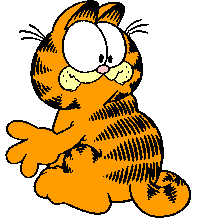skip to main |
skip to sidebar
More Trivia About Cats

- 95% of cat owners admit they talk to their cats.
- A cat can be either right-pawed or left-pawed.
- A cat can jump as much as seven times its height.
- A cat in a hurry can sprint at about thirty-one miles per hour.
- A cat sees about six times better than a human at night because of the tapetum lucidum , a layer of extra reflecting cells which absorb light.
- A cat will clean itself with paw and tongue after a dangerous experience or when it has fought with another cat. This is believed to be an attempt by the animal to soothe its nerves by doing something natural and instinctive.
- A cat will never break a sweat because it has no sweat glands.
- A cat will spend nearly 30% of its life grooming itself.
- A cat's brain is more similar to a human's brain than that of a dog.
- A cat's ear pivots 180 degrees.
- A cat's jaws cannot move sideways.
- A cat's sense of taste is keener than a dog's sense of taste.
- A cat's tail held high means happiness. A twitching tail is a warning sign, and a tail tucked in close to the body is a sure sign of insecurity.
- A cat's whiskers, called vibrissae, grow on the cat's face and on the back of its forelegs. The whiskers are thought to be a kind of sensor to help a cat gauge the space it wants to go through.
- A fifteen year old cat has probably spent ten years of its life sleeping.
- A group of adult cats is called a clowder.
- A group of kittens is called a kindle.
- A polecat is not a cat. It is a nocturnal European weasel.
- A quarter of cat owners blow dry their cats after bathing them.
- Abraham Lincoln loved cats. He had four of them while he lived in the White House.
- Abraham Lincoln's cat, Tabby, was the first of several White House cats.
- Adult cats with no health problems are in deep sleep 15 percent of their lives. They are in light sleep 50 percent of the time.
- After being handled, cats lick themselves to smooth their fur and get rid of the "human" smell. Licking is also thought to produce a calming effect.
- Ailurophobia is the fear of cats. Julius Caesar, Henry II, Charles XI, and Napoleon all suffered from this and would nearly faint in the presence of a cat.
- All cats are born with blue eyes.
- All cats are members of the family Felidea. Interestingly enough, the cat family split from the other mammals at least 40,000,000 years ago, making them one of the oldest mammalian families.
- Americans spend more than 5.4 billion dollars on their pets each year.
- At night a cat can gather into the extra-large corneas and lenses of its eyes more than six times the amount of light than humans can. Seeing far better than humans do at night time and tending to focus best at a distance of eight to twenty feet makes cats excellent night time hunters.
- Black cat superstitions originated in America. In Asia and England, a black cat is considered lucky.
- Both humans and cats have identical regions in the brain responsible for emotion.
- Cardinal Richelieu was so fond of cats that he shared his home with 14 of them. Specially appointed attendants cared for them, and upon his death, the Cardinal left all his worldly wealth to his feline companions.
- Cat families usually play best in even numbers. Cats and kittens should be acquired in pairs whenever possible.
- Cat scratch disease, a benign but sometimes painful disease of short duration, is caused by a bacillus. Despite its name, the disease can be transmitted by many kinds of scratches besides those of cats.
- Catnip can affect lions and tigers as well as house cats. It excites them because it contains a chemical that resembles an excretion of the dominant female's urine.
- Cats are sometimes born with extra toes. This is called polydactyl.
- Cats are the only domestic animals that walk directly on their claws, not on their paws. This method of walking is called "digitigrade." When cats scratch furniture, it isn't an act of malice. They are actually tearing off the ragged edges of the sheaths of their talons to expose the new sharp ones beneath.
- Cats average 16 hours of sleep a day, more than any other mammal.
- Cats bury their feces to cover their trails from predators.
- Cats can donate blood to other cats.
- Cats can get "age spots". These are black spots on the skin that are often seen around the lips, eyes, and nose; and usually start when the cat is three to five years of age.
- Cats can get bored. They show their boredom by excessive licking, chewing, or biting.
- Cats can have freckles. They can appear anywhere on a cat's skin and even in its mouth.
- Cats can learn tricks. They just sometimes choose not to.
- Cats can see up to 120 feet away. Their peripheral vision is about 285 degrees.
- Cats have 13 ribs.
- Cats have a homing ability that uses its biological clock, the angle of the sun, and the Earth's magnetic field.
- Cats have a third eyelid, called a haw, that is rarely visible. If it can be seen, it could be an indication of ill health.
- Cats have AB blood groups just like people.
- Cats have better memories than dogs. Tests conducted by the University of Michigan concluded that while a dogs memory lasts no more than 5 minutes, a cat's can last as long as 16 hours - exceeding even that of monkeys and orangutans.
- Cats have carpal pads on their front paws that help to prevent them from sliding on a slippery surface when jumping.
- Cats love to hear the sound of their own name and your voice, so talk to them often.
- Cats must have fat in their diet, because they can't produce it on their own. Never feed your cat dog food, because cats need five times more protein than dogs do.
- Cats purr at about 26 cycles per second, the same frequency as an idling diesel engine.
- Cats scratch to shed the sheaths of their old claws.
- Cats use more than 500 muscles to leap, jump, and sprint.
- Cats, not dogs, are the most common pets in America. There are approximately 66 million cats to 58 million dogs, with Parakeets a distant third at 14 million.
- Despite its reputation for being finicky, the average cat consumes about 127,750 calories a year, nearly 28 times its own weight in food and the same amount again in liquids. In case you were wondering, cats cannot survive on a vegetarian diet.
- Ear furnishings are the hairs that grow inside a cat's ears.
- Ernest Hemingway once had some 30 cats at his home in Havana.
- Florence Nightingale owned more than 60 cats in her lifetime.
- Human painkillers such acetaminophen (Tylenol) are toxic to cats. Chocolate is also poisonous to cats.
- If your cat is in the habit of rolling over and exposing his stomach, you can be sure he feels perfectly safe with you. It's also a way of demonstrating his pleasure in your company.
- In ancient Egypt, the entire family would shave their eyebrows off as a sign of mourning when the family cat died.
- In general, cats live longer than most dogs. An average life span might be 12 to 14 years. Some cats are reaching 20 or more. A cat's longevity depends on feeding, genetics, environment, veterinary care and some other factors. It is also important whether or not the cat lives indoors or is allowed outdoors (outdoor cats live an average of eight years). The general consensus is that at about age seven the cat can be considered as "middle-aged", and at age 10 and beyond - old.
- In relation to their body size, cats have the largest eyes of any mammal.
- Many cats are unable to properly digest cow's milk. Milk and milk products give them diarrhea.
- Many of a cat's bones are found in its tail.
- More than 30 percent of American households have a cat as part of the family.
- Morris, the 9-Lives cat, was discovered at an animal shelter in New England.
- Newborn kittens have closed ear canals that don't begin to open for nine days.
- Nostradamus, the French Astrologer, 1503-1566, had a cat named Grimalkin.
- One litter box per cat, plus an extra box, is the best formula for a multi-cat household.
- Orange and lemon rinds are offensive to cats. A light rubbing of orange peel on furniture will discourage your cat from using it as a scratching post.
- The average canned or dry cat meal is the nutritional equivalent of eating five mice.
- The cheetah is the only cat in the world that can't retract its claws.
- The declawing of a pet cat involves surgery called an onychectomy, in which the entire claw and end bone of each toe of the animal are amputated.
- The different types of tabby patterns that are seen in domestic cats also occur in wild cats.
- The only domestic animal not mentioned in the Bible is the cat.
- The Persian cat has the longest and thickest fur of all domestic cats. The topcoat may be up to 5 inches long.
- The phenomenon of cats finding their owners in a place where they have never been before is scientifically known as Psi-trailing. Many well-documented stories tell of cats that have walked hundreds, even thousands of miles to find their owners.
- The silver tabby cat is a Teku.
- The Turkish Van, a very old rare breed that originated in Turkey, is quite different from other breeds because of its unusual love of water. Known as "the swimming cat," the Van is strong, quick and agile. He makes a devoted and loyal companion--on land or at sea.
- Those dark lines connecting to a cat's eyes are called mascara lines.
- When you find your cat glued to the window intently watching a bird, making a strange chattering noise and clicking his or her jaws oddly, your cat is merely acting on instinct. What your cat is doing is directly related to the killing bite that all cats (both domestic and wild cats) use to dispatch their prey.
- Winston Churchill, adored cats. Churchill used to refer to his cat, "Jock", as his special assistant. "Jock" was reported to be on the bed with his master on the day the great British statesman died.
- Young cats can distinguish between two identical sounds that are just 18 inches apart at a distance of up to 60 feet.


No comments:
Post a Comment